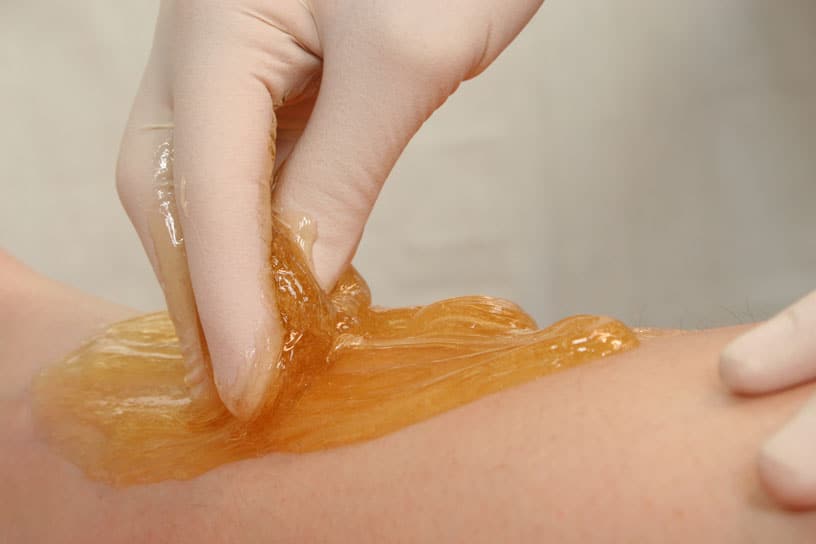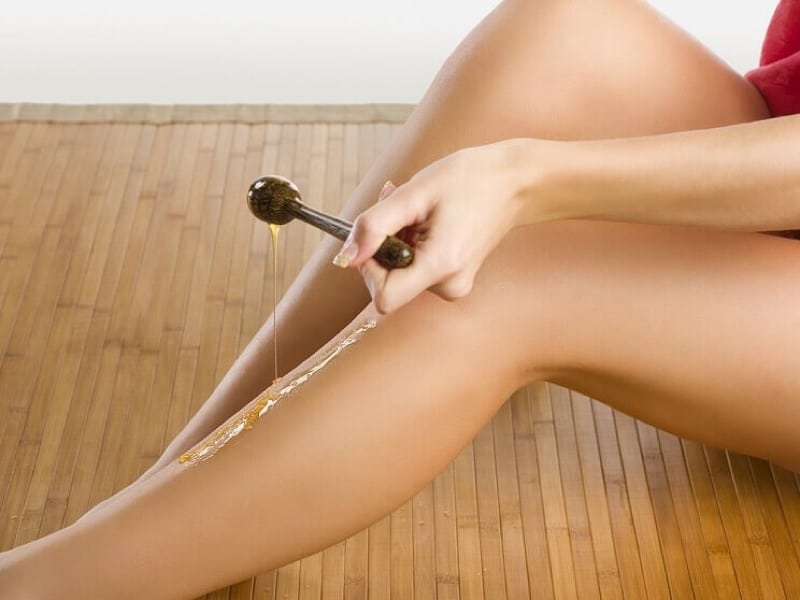As we explore the vast world of hair removal methods, it’s clear that everyone has their own preference. Waxing and shaving reign supreme as the most popular and common techniques, but there’s so much more out there. One method that’s been gaining traction in recent years is the sugaring hair removal method. It might not be perfect, but it certainly comes close.
Sugaring is an ancient and effective hair removal technique, with a rich history and impressive results. In the following article, we’ll delve deep into the intricacies of this method and provide detailed information on the process, benefits, and even some of the key players in the industry, like Sugared + Bronzed and their founder. Additionally, we’ll introduce you to the role of a Sugarista, an expert in the art of sugaring hair removal. So, join us as we uncover the wonders of sugaring and why it’s becoming a top choice for many.
Chapter Overview
What Is Sugaring?
Sugaring is an organic and safe hair removal method that has been used since ancient times in the Middle East. A sugar paste made of lemon, water, and sugar is applied to various parts of the body, including the bikini area, legs, face, arms, and underarms, effectively removing hair without causing damage to live skin cells. This results in smooth, hairless skin that lasts between three and five weeks.
The simple process of sugaring involves the following steps:
- Warm sugar paste: The sugaring paste is heated until it’s spreadable.
- Application: We apply the paste onto the desired area in the direction of hair growth.
- Hardening: We allow the paste to harden for a few seconds.
- Removal: We gently pull off the paste, lifting the hair from the root without pulling at the skin.
The technique’s benefits include:
- Organic ingredients: Lemon, water, and sugar are all-natural and even edible.
- Less skin irritation: Unlike waxing, sugaring doesn’t stick to or pull live skin cells.
- Versatile: It can be used on any part of the body, including sensitive areas like the face.
Overall, sugaring is a gentle and effective hair removal method that has stood the test of time.
Benefits of Sugaring
We’ve gathered some notable advantages of sugaring to guide your decision-making process:
- Efficiency: Sugaring can be performed faster than waxing as the sugar paste can be applied to a large area. Once you or your esthetician gain experience, it can take just a few minutes.
- Easy cleanup: Since sugar is water-soluble, it can be effortlessly removed from the skin with water, eliminating any discomfort. Wax, conversely, requires an oil-based remover.
- Gentler on the skin: The natural ingredients in sugar paste make it less painful and more comfortable for sensitive skin types. Unlike wax, there’s no fear of irritation if the paste is applied to a recently sugared area, making it perfect for catching missed hairs.
- Reduced hair growth: As a less invasive method, frequent sugaring can lead to weakened hair follicles, ultimately minimizing hair growth over time.
Although it depends on personal preferences and individual skin types, these benefits might make sugaring the ideal hair removal method for you.
Downsides of Sugaring
While sugaring has its benefits, it’s important to consider potential drawbacks:
- Limited availability: Not all salons offer sugaring, making it harder to find a practitioner.
- Difficulty at home: Achieving the right consistency for the sugar paste can be tricky without experience.
- Hair length requirement: Sugaring requires a quarter-inch of hair growth, meaning you must tolerate some hair growth.
- Incompatibility with certain products: Sugaring is not recommended for those using vitamin C or retinol skincare products.
- Skin concerns: Sugaring should be avoided on areas with bruises, swelling, rashes, cold sores, or open sores.
Despite these downsides, many still find sugaring to be a preferred hair removal method due to its gentle nature and longer-lasting results. Weighing the pros and cons will help you make an informed decision for your personal needs.
Difference Between Sugaring and Waxing
In comparing hair removal methods, it’s crucial to understand the primary distinction between sugaring and waxing. The key difference lies in the direction of paste application. For sugaring, we apply the paste opposite the hair growth direction and then pull it in the direction of growth. This technique ensures effective hair removal without breakage. Comparatively, other methods like laser hair removal, shaving, and threading have differing techniques and potential for irritation or damage.
Does Sugaring Hurt?
When considering hair removal methods, pain and discomfort are common concerns. Sugaring, overall, is less painful than waxing. This is because the sugaring paste does not stick to live skin cells, resulting in less irritation and pain.
However, the initial sugaring experience might be more uncomfortable if transitioning from shaving or waxing. This is due to hairs being more difficult to grab at first. But fear not, as sugaring becomes less painful over time. With consistent sugaring, hair grows thinner, making the process increasingly less uncomfortable.
It’s also important to consider external factors impacting pain tolerance, such as menstrual cycles. The bikini area tends to be more sensitive during this time. We recommend scheduling sugaring appointments five days after your period has ended to minimize discomfort.
In summary:
- Sugaring generally hurts less than waxing
- Initial sugaring experiences may be more uncomfortable when transitioning from shaving or waxing
- Consistent sugaring leads to thinner hair growth and less pain
- Schedule around menstruation cycle for reduced discomfort
How Often Should You Remove Hair?
We recommend removing hair once every three to five weeks. This frequency allows for hair to be visible, making it easier to pull off during sugaring. Personal preference and individual hair growth rates can influence this timeline. In cases where hair grows faster, removal can be done closer to the three-week mark, rather than waiting for six weeks.
What Is The Aftercare?
After sugaring, it’s crucial to take care of our skin to prevent ingrown hairs. Here’s what we need to do:
- Exfoliation: Gently exfoliate every three days to remove dead skin cells and keep pores clear.
- Cold Shower: Close up pores by taking a cold shower after the treatment.
- Avoid Sweating: Refrain from any activities that cause excessive sweating for 24 to 48 hours, such as sex or working out.
- Loose Clothing: Wear breathable and loose-fitting clothes to ensure our skin can breathe and recover properly.
- Consultation: If needed, consult a board-certified dermatologist for any persistent issues or further advice.
How Much Does It Cost?
Sugaring costs tend to vary between salons and spas. Here are some general price points to consider:
- Full Legs: Up to $100
- Upper Lip: $15
We must note that sugaring is typically more expensive than waxing due to its natural ingredients and less common availability. However, you can always try making it at home to save on costs. Remember to choose a reputable esthetician and book an appointment to ensure quality service.
How To DIY Sugaring?

To make your sugaring paste, you’ll need the following ingredients:
- 2 cups of organic cane sugar
- 1/4 cup of water
- 1/4 cup of lemon juice
Follow these steps to create the sugaring paste and perform the treatment:
- Prepare the paste: Combine sugar, water, and lemon juice in a pot or saucepan over medium heat. Stir constantly to prevent burning.
- Simmer: Once boiling, reduce heat to medium-low and let the paste simmer for 25 more minutes.
- Cool and store: When the color turns dark amber, remove from heat and allow it to cool for 10 minutes. Transfer the paste to an airtight, heat-safe container, and let it cool to room temperature.
- Clean your hands: Always start with clean hands. Take a handful of the now-cooled paste and warm it up between your hands.
- Apply the paste: Spread the paste onto the area where you want to remove hair, going against the direction of hair growth.
- Flick off: Allow the paste to harden for a few seconds, and then quickly flick it off in the direction of hair growth. You may repeat the process in an area if necessary.
- Monitor for irritation: If redness or irritation occurs, stop and wait a few weeks before attempting sugaring again.
Remember, for the best results, it is always recommended to have your first sugaring session done by a professional. After that, you can use this sugaring technique at home as needed.

